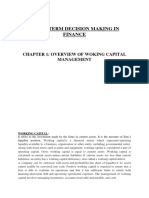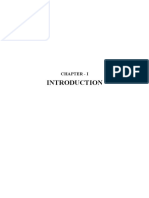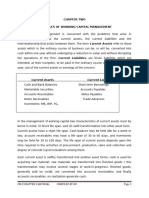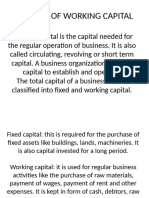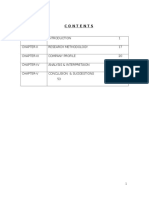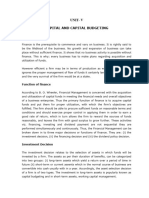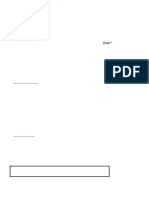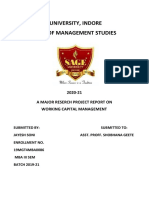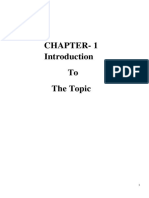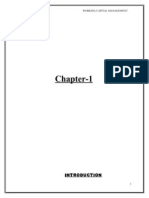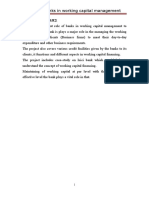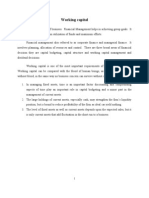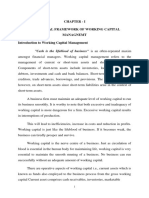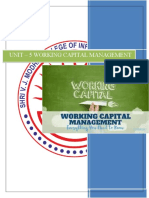FM II Chapter Three Revised by Kefe
Uploaded by
kefeFM II Chapter Three Revised by Kefe
Uploaded by
kefeFINANCIAL MANAGEMENT II
CHAPTER THREE
PRINCIPLES OF WORKING CAPITAL MANAGEMENT
INTRODUCTION
Working capital management is also one of the important parts of the financial management. It is
concerned with short-term finance of the business concern which is a closely related trade
between profitability and liquidity. Efficient working capital management leads to improve the
operating performance of the business concern and it helps to meet the short term liquidity.
Short-term, or current assets and liabilities are collectively known as working capital. It
measures how much in liquid assets a company has available to build its business. Positive
working capital is needed to ensure that a firm is able to continue its operations and that it has
sufficient funds to satisfy both maturing short term debt and upcoming operational expenses. The
management of working capital involves managing inventories, account receivable and payable
and cash.
An increase in working capital indicates that the business has either increased current assets (that
is received cash, or other current assets) or has decreased current liabilities, for example, if it has
paid some short term debts from creditors.
Decision relating to working capital and short term financing are referred to as working capital
management. Active working capital management is an extremely effective way to increase
enterprise value. Optimizing working capital results in a rapid release of liquid resources and
contributes to an improvement in free cash flow and to a permanent reduction in inventory and
capital costs, thereby increasing liquidity for strategic investment and debt deduction.
The fundamental principles of working capital management are reducing the capital employed
and improving efficiency in the areas of receivables, inventories, and payables. Working capital
is essential for long-term success of a business. No business can survive, if it cannot meet its
day-to-day obligations. A business must therefore have clear policies for the management of
each component of working capital.
Working capital concepts
Working capital, sometimes called gross working capital, simply refers to current assets
used in operations.
Net working capital is defined as current assets minus current liabilities.
Complied By: Kefiyalew B.Bayu(MSc) Page 1
Net operating working capital is defined as current assets minus none interest- bearing
current liabilities. More specifically, net operating working capital is often expressed as cash
and marketable securities, accounts receivable, and inventories, less accounts payable and
accruals.
The current ratio, which is calculated by dividing current assets by current liabilities and it is
intended to measure liquidity. However, a high current ratio does not ensure that a firm will
have the cash required to meet its needs. If inventories cannot be sold, or if receivables
cannot be collected in a timely manner, then the apparent safety reflected in a high current
ratio could be illusory.
The quick ratio, or acid test, also attempts to measure liquidity, and it is found by
subtracting inventories from current assets and then dividing by current liabilities. The quick
ratio removes inventories from current assets because they are the least liquid of current
assets. Therefore, the quick ratio is an “acid test” of a company’s ability to meet its current
obligations.
The best and most comprehensive picture of a firm’s liquidity position is shown by its cash
budget. This statement, which forecasts cash inflows and outflows, focuses on what really
counts, namely, the firm’s ability to generate sufficient cash inflows to meet its required cash
outflows. We will discuss cash budgeting in detail later in the chapter.
Working capital policy refers to the firm’s policies regarding (1) target levels for each
category of current assets and (2) how current assets will be financed.
Working capital management involves both setting working capital policy and carrying out
that policy in day-to-day operations.
Characteristics of working capital management confines with the characteristics of the
components of working capital.
It has short life span: cash balances may hold idle for a week or two, thus accounts may have
a life of 30-60 days.
Swift transformation in to other asset forms: i.e each current asset is swiftly transformed in to
other assets from like cash is used for acquiring raw materials, raw materials are transformed
in to finished goods and these sold on credit are convertible in to account receivables and
finally in to cash.
The Components of Working Capital
Current Assets: One important current asset is accounts receivable. Accounts receivable arise
because companies do not usually expect customers to pay for their purchases immediately.
Complied By: Kefiyalew B.Bayu(MSc) Page 2
These unpaid bills are a valuable asset that companies expect to be able to turn into cash in the
near future. The bulk of accounts receivable consists of unpaid bills from sales to other
companies and are known as trade credit. The remainder arises from the sale of goods to the
final consumer. These are known as consumer credit.
Another important current asset is inventory. Inventories may consist of raw materials, work in
process, or finished goods awaiting sale and shipment.
The remaining current assets are cash and marketable securities. The cash consists partly of
dollar bills, but most of the cash is in the form of bank deposits. These may be demand deposits
(money in checking accounts that the firm can pay out immediately) and time deposits (money in
savings accounts that can be paid out only with a delay).
The principal marketable security is commercial paper (short-term unsecured debt sold by other
firms). Other securities include Treasury bills, which are short-term debts sold by federal
government, and state and local government securities.
Current Liabilities: We have seen that a company’s principal current asset consists of unpaid
bills. One firm’s credit must be another’s debit. Therefore, it is not surprising that a company’s
principal current liability consists of accounts payable—that is, outstanding payments due to
other companies.
The other major current liability consists of short-term borrowing.
NEEDS OF WORKING CAPITAL
Working Capital is an essential part of the business concern. Every business concern must
maintain certain amount of Working Capital for their day-to-day requirements and meet the
short-term obligations.
Working Capital is needed for the following purposes.
I. Purchase of raw materials and spares: The basic part of manufacturing process is, raw
materials. It should purchase frequently according to the needs of the business concern.
Hence, every business concern maintains certain amount as Working Capital to purchase raw
materials, components, spares, etc.
II. Payment of wages and salary: The next part of Working Capital is payment of wages and
salaries to labour and employees. Periodical payment facilities make employees perfect in
their work. So a business concern maintains adequate the amount of working capital to make
the payment of wages and salaries.
Complied By: Kefiyalew B.Bayu(MSc) Page 3
III. Day-to-day expenses: A business concern has to meet various expenditures regarding the
operations at daily basis like fuel, power, office expenses, etc.
IV. Provide credit obligations: A business concern responsible to provide credit facilities to the
customer and meet the short-term obligation. So the concern must provide adequate Working
Capital.
Determinants of working capital requirements or management
Working Capital requirements depends upon various factors. There are no set of rules or formula
to determine the Working Capital needs of the business concern. The following are the major
factors which are determining the Working Capital requirements.
a) Nature of business: Working Capital of the business concerns largely depend upon the
nature of the business. If the business concerns follow rigid credit policy and sell goods only
for cash, they can maintain lesser amount of Working Capital. A transport company
maintains lesser amount of Working Capital while a construction company maintains larger
amount of Working Capital.
b) Production cycle: Amount of Working Capital depends upon the length of the production
cycle. If the production cycle length is small, they need to maintain lesser amount of
Working Capital. If it is not, they have to maintain large amount of Working Capital.
c) Business cycle: Business fluctuations lead to cyclical and seasonal changes in the business
condition and it will affect the requirements of the Working Capital. In the booming
conditions, the Working Capital requirement is larger and in the depression condition,
requirement of Working Capital will reduce. Better business results lead to increase the
Working Capital requirements.
d) Production policy: It is also one of the factors which affects the Working Capital
requirement of the business concern. If the company maintains the continuous production
policy, there is a need of regular Working Capital. If the production policy of the company
depends upon the situation or conditions, Working Capital requirement will depend upon the
conditions laid down by the company.
e) Credit policy: Credit policy of sales and purchase also affect the Working Capital
requirements of the business concern. If the company maintains liberal credit policy to
collect the payments from its customers, they have to maintain more Working Capital. If the
company pays the dues on the last date it will create the cash maintenance in hand and bank.
Complied By: Kefiyalew B.Bayu(MSc) Page 4
f) Growth and expansion: During the growth and expansion of the business concern, Working
Capital requirements are higher, because it needs some additional Working Capital and
incurs some extra expenses at the initial stages.
g) Availability of raw materials: Major part of the Working Capital requirements are largely
depend on the availability of raw materials. Raw materials are the basic components of the
production process. If the raw material is not readily available, it leads to production
stoppage. So, the concern must maintain adequate raw material; for that purpose, they have
to spend some amount of Working Capital.
h) Earning capacity: If the business concern consists of high level of earning capacity, they
can generate more Working Capital, with the help of cash from operation. Earning capacity is
also one of the factors which determines the Working Capital requirements of the business
concern.
OPERATING AND CASH CYCLE
Operating cycle is the time duration required to convert sales, after the conversion of resources in
to inventories, in to cash. The operating cycle of a manufacturing company involves three
phases.
Acquisition of resources such as raw materials, labour, power, fuel, etc
Manufacturing of the product which includes conversion of raw materials in to work-in-
progress in to finished goods.
Sale of the product either for cash or on credit. Credit sale create account receivable for
collection.
The components of working capital constantly change with the cycle of operations, but the
amount of working capital is fixed. This is one reason why net working capital is useful
summary measure of current.
Cash
Receivables Raw materials inventory
Finished goods inventory
Figure:1 Simple cycle of operation
Complied By: Kefiyalew B.Bayu(MSc) Page 5
If you prepare the firm’s balance sheet at the beginning of the process, you will see cash (a
current asset). If you delay a little you will find the cash replaced first by inventories of raw
materials and then by inventories of finished goods (also a current asset). When the goods are
sold, the inventories give way to receivable ( another current asset) and finally, when the
customers pay their bills, the firms takes out its profit and replenishes the cash balance.
Figure:2 cash conversion cycle
The above figure depicts four key dates in the production cycle that influence the firm’s
investment in working capital. The firm starts the cycle by purchasing raw materials, but it does
not pay for them immediately. This delay is the accounts payable period. The firm processes the
raw material and then sells the finished goods. The delay between the initial investment in
inventories and the sale date is the inventory period. Sometime after the firm has sold the goods
its customers pay their bills. The delay between the date of sale and the date at which the firm is
paid is the accounts receivable period.
The top part shows that the total delay between initial purchase of raw materials and ultimate
payments from customers is the sum of the inventory and accounts receivable periods: first the
raw materials must be purchased, processed, and sold, and then the bills must be collected.
However, the net time that the company is out of cash is reduced by the time it takes to pay its
own bills. The length of time between the firm’s payment for its raw materials and the collection
of payment from the customer is known as the firm’s cash conversion cycle (CCC). To
summarize,
CCC = (inventory period + receivables period) – accounts payable period
Complied By: Kefiyalew B.Bayu(MSc) Page 6
The longer the production process, the more cash the firm must keep tied up in inventories.
Similarly, the longer it takes customers to pay their bills, the higher the value of accounts
receivable. On the other hand, if a firm can delay paying for its own materials, it may reduce the
amount of cash it needs. In other words, accounts payable reduce net working capital.
or
The ratio of inventory to daily output measures the average number of days from the purchase of
the inventories to the final sale.
,or
,or
Question: AB Co. has the following current assets and current liabilities for the year ended 2013
of first quarter.
Current assets (In Millions) Current Liabilities (In Millions)
Cash $114 Short term loans $203
Marketable securities 89 Account payable 303
Account receivables 481 Accrued income taxes 46
Inventories 468 Current payment due on
Other Current Assets 201 long term debt 68
Total Current assets $1,353 Other C/Liabilities 427
Total current liab. $1,047
In addition to the above data, AB Co. has the following data in millions.
Income statement data Balance sheet data
Year ended, first quarter 2013 End of last quarter 2012
Sales $3,968 Inventory $470
Costs of goods sold 3,518 Account Receivable 471
Account Payable 304
Complied By: Kefiyalew B.Bayu(MSc) Page 7
Required: a) calculate networking capital.
b) How long AB Com. does it take to produce and sell their products?
c) How long does it take to collect bills?
d) How long does it take to pay bills?
e) How long is the conversion cycle and cash conversion cycle?
TYPES OF WORKING CAPITAL
Permanent Working Capital
It is also known as Fixed Working Capital. It is the capital; the business concern must maintain
certain amount of capital at minimum level at all times. It is continuously required by a firm to
carry on its business operations. The level of Permanent Capital depends upon the nature of the
business. Permanent or Fixed Working Capital will not change irrespective of time or volume of
sales.
Amount permanent working capital
of working capital
time
permanent working capital
Temporary Working Capital
It is also known as variable working capital. It is the amount of capital which is required to meet
the Seasonal demands and some special purposes. It can be further classified into Seasonal
Working Capital and Special Working Capital. The capital required to meet the seasonal needs
of the business concern is called as Seasonal Working Capital. The capital required to meet the
special emergency such as launching of extensive marketing campaigns for conducting research,
etc.
Amount of
working temporary working capital
capital
time
Temporary working capital
Complied By: Kefiyalew B.Bayu(MSc) Page 8
Balanced Working Capital Position
A business concern must maintain a sound Working Capital position to improve the efficiency of
business operation and efficient management of finance. Both excessive and inadequate working
capital leads to some problems in the business concern.
Causes and effects of excessive working capital
(i) Excessive Working Capital leads to unnecessary accumulation of raw materials, components
and spares.
(ii) Excessive Working Capital results in locking up of excess Working Capital.
(iii) It creates bad debts
(iv) It leads to reduce the profits.
Causes and effects of inadequate working capital
(i) Inadequate working capital cannot buy its requirements in bulk order.
(ii) It becomes difficult to implement operating plans and activate the firm’s profit target.
(iii) It becomes impossible to utilize efficiently the fixed assets.
(iv) The rate of return on investments also falls with the shortage of Working Capital.
(v) It reduces the overall operation of the business.
WORKING CAPITAL MANAGEMENT POLICY
Working Capital Management formulates policies to manage and handle efficiently; for that
purpose, the management established three policies based on the relationship between Sales and
Working Capital.
1. Conservative Working Capital Policy: maintain a higher level of Working Capital to minimize
risk. This type of Working Capital Policy is suitable to meet the seasonal fluctuation of the
manufacturing operation.
2. Moderate Working Capital Policy: maintains the moderate level of Working Capital
according to moderate level of sales.
3. Aggressive Working Capital Policy: maintains low level of Working Capital against the high
level of sales in the business concern during a particular period.
Complied By: Kefiyalew B.Bayu(MSc) Page 9
You might also like
- Principles of Working Capital Management-1No ratings yetPrinciples of Working Capital Management-129 pages
- Financial Management - Lecture Notes, Study Material and Important Questions, Answers67% (3)Financial Management - Lecture Notes, Study Material and Important Questions, Answers5 pages
- Working Capital Management by Birla GroupNo ratings yetWorking Capital Management by Birla Group39 pages
- Module - 1 Working Capital Management: MeaningNo ratings yetModule - 1 Working Capital Management: Meaning30 pages
- Module - 1 Working Capital Management: MeaningNo ratings yetModule - 1 Working Capital Management: Meaning30 pages
- Module I Overview of Working Capital TheoryNo ratings yetModule I Overview of Working Capital Theory15 pages
- Working Capital Management in Vardhman-Final Project100% (3)Working Capital Management in Vardhman-Final Project84 pages
- PRINCIPLE OF WORKING CAPITAL intro to mgt 2No ratings yetPRINCIPLE OF WORKING CAPITAL intro to mgt 223 pages
- LCM MBA Summer Training Project SAIL WCNo ratings yetLCM MBA Summer Training Project SAIL WC85 pages
- Acc 301 Corporate Finance - Lectures Two - ThreeNo ratings yetAcc 301 Corporate Finance - Lectures Two - Three17 pages
- Sage University, Indore Institute of Management StudiesNo ratings yetSage University, Indore Institute of Management Studies14 pages
- Chapter 1.1 Working Capital Management 1.1 .1conceptNo ratings yetChapter 1.1 Working Capital Management 1.1 .1concept55 pages
- Yashoda Again Edit Content File.........................No ratings yetYashoda Again Edit Content File.........................64 pages
- B.A. (Hons.) Eco - Sem-II - Finance (GE) - WorkingCapital - RuchikaChoudharyNo ratings yetB.A. (Hons.) Eco - Sem-II - Finance (GE) - WorkingCapital - RuchikaChoudhary10 pages
- Chapter Ii: Working Capital Management - A Conceptual OverviewNo ratings yetChapter Ii: Working Capital Management - A Conceptual Overview8 pages
- Anandhu-Working Capital Management at Trivantracore Cement LTD 1500 Without CertificateNo ratings yetAnandhu-Working Capital Management at Trivantracore Cement LTD 1500 Without Certificate57 pages
- Role of Banks in Working Capital ManagementNo ratings yetRole of Banks in Working Capital Management59 pages
- Anagement of Orking Apital: Learning OutcomesNo ratings yetAnagement of Orking Apital: Learning Outcomes33 pages
- Name Registration No Sex Sign: Salum Warsh Dicholile T/UDOM/2020/07895 MNo ratings yetName Registration No Sex Sign: Salum Warsh Dicholile T/UDOM/2020/07895 M4 pages
- Dick S Sporting Goods Is A Chain of Full Line Sporting GoodsNo ratings yetDick S Sporting Goods Is A Chain of Full Line Sporting Goods1 page
- A Study On Working Capital Management in Hindustan Unilever LimitedNo ratings yetA Study On Working Capital Management in Hindustan Unilever Limited11 pages
- Silkoset R. Pricing. A Guide To Pricing Decisions 2023No ratings yetSilkoset R. Pricing. A Guide To Pricing Decisions 2023239 pages
- Multiple Choice: - Computational (Cont.)No ratings yetMultiple Choice: - Computational (Cont.)5 pages
- Chapter Ii - Review of Literature: Equity Analysis0% (1)Chapter Ii - Review of Literature: Equity Analysis82 pages
- Immediate Download (Original PDF) Governmental and Nonprofit Accounting 11th Edition Ebooks 2024100% (7)Immediate Download (Original PDF) Governmental and Nonprofit Accounting 11th Edition Ebooks 202441 pages
- Capital Budgeting: Value (Brigham and Ehrhardt, 2005)No ratings yetCapital Budgeting: Value (Brigham and Ehrhardt, 2005)57 pages
- UFP Acc and Finance PRACTICE PAPER 1 MS (For Jan 24 Students)No ratings yetUFP Acc and Finance PRACTICE PAPER 1 MS (For Jan 24 Students)15 pages
- Zensar Technologies Q4FY24 Result Update - 26042024 - 26!04!2024 - 11No ratings yetZensar Technologies Q4FY24 Result Update - 26042024 - 26!04!2024 - 119 pages
- Espresso Software Financial Statements and Supplementary DataNo ratings yetEspresso Software Financial Statements and Supplementary Data38 pages
- 1standard Letter of Offer For An Open Offer in TermsNo ratings yet1standard Letter of Offer For An Open Offer in Terms20 pages
- Effect of Financial Performance On Stock Return: Evidence From The Food and Beverages SectorNo ratings yetEffect of Financial Performance On Stock Return: Evidence From The Food and Beverages Sector17 pages
- Hindustan Unilever Limited Projections For Balance Sheet, Profit and Loss and Cash Flow StatementNo ratings yetHindustan Unilever Limited Projections For Balance Sheet, Profit and Loss and Cash Flow Statement24 pages
- Financial Management - Lecture Notes, Study Material and Important Questions, AnswersFinancial Management - Lecture Notes, Study Material and Important Questions, Answers
- Working Capital Management in Vardhman-Final ProjectWorking Capital Management in Vardhman-Final Project
- Sage University, Indore Institute of Management StudiesSage University, Indore Institute of Management Studies
- Chapter 1.1 Working Capital Management 1.1 .1conceptChapter 1.1 Working Capital Management 1.1 .1concept
- Yashoda Again Edit Content File.........................Yashoda Again Edit Content File.........................
- B.A. (Hons.) Eco - Sem-II - Finance (GE) - WorkingCapital - RuchikaChoudharyB.A. (Hons.) Eco - Sem-II - Finance (GE) - WorkingCapital - RuchikaChoudhary
- Chapter Ii: Working Capital Management - A Conceptual OverviewChapter Ii: Working Capital Management - A Conceptual Overview
- Anandhu-Working Capital Management at Trivantracore Cement LTD 1500 Without CertificateAnandhu-Working Capital Management at Trivantracore Cement LTD 1500 Without Certificate
- Name Registration No Sex Sign: Salum Warsh Dicholile T/UDOM/2020/07895 MName Registration No Sex Sign: Salum Warsh Dicholile T/UDOM/2020/07895 M
- Dick S Sporting Goods Is A Chain of Full Line Sporting GoodsDick S Sporting Goods Is A Chain of Full Line Sporting Goods
- A Study On Working Capital Management in Hindustan Unilever LimitedA Study On Working Capital Management in Hindustan Unilever Limited
- Silkoset R. Pricing. A Guide To Pricing Decisions 2023Silkoset R. Pricing. A Guide To Pricing Decisions 2023
- Chapter Ii - Review of Literature: Equity AnalysisChapter Ii - Review of Literature: Equity Analysis
- Immediate Download (Original PDF) Governmental and Nonprofit Accounting 11th Edition Ebooks 2024Immediate Download (Original PDF) Governmental and Nonprofit Accounting 11th Edition Ebooks 2024
- Capital Budgeting: Value (Brigham and Ehrhardt, 2005)Capital Budgeting: Value (Brigham and Ehrhardt, 2005)
- UFP Acc and Finance PRACTICE PAPER 1 MS (For Jan 24 Students)UFP Acc and Finance PRACTICE PAPER 1 MS (For Jan 24 Students)
- Zensar Technologies Q4FY24 Result Update - 26042024 - 26!04!2024 - 11Zensar Technologies Q4FY24 Result Update - 26042024 - 26!04!2024 - 11
- Espresso Software Financial Statements and Supplementary DataEspresso Software Financial Statements and Supplementary Data
- 1standard Letter of Offer For An Open Offer in Terms1standard Letter of Offer For An Open Offer in Terms
- Effect of Financial Performance On Stock Return: Evidence From The Food and Beverages SectorEffect of Financial Performance On Stock Return: Evidence From The Food and Beverages Sector
- Hindustan Unilever Limited Projections For Balance Sheet, Profit and Loss and Cash Flow StatementHindustan Unilever Limited Projections For Balance Sheet, Profit and Loss and Cash Flow Statement













